GOT MICE IN YOUR HOUSE?
By Chris Williams on July 22, 2019.
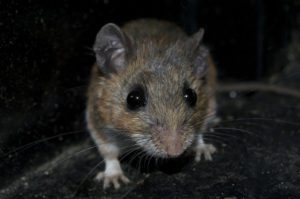
Shutterstock
Discovering that you have mice living in your house can be very unsettling, in fact downright creepy. But don’t panic; we’re going to walk you through the problem. By the time you finish reading this, you will know why you have mice, how to get rid of them, and how to keep them out in the future!
WHY MY HOUSE ANYWAY?
Mice might get indoors accidentally, sometimes brought in by the family cat! More often, mice move inside deliberately in search of either food or shelter, or both. Mice enter buildings most often in the fall as weather gets colder and food supplies dwindle, but expect them at any time of the year. The reason that you ended up with mice in your house may be because you had a good-sized population of mice in your yard to begin with, and probably didn’t even realize it. Every property has mice outside but sometimes our lifestyles invite even more mice to make themselves at home.
These are just some of the outside conditions that can attract mice to residential properties. The closer these are to your house, the more likely that mice will find their way inside:
Outdoor Mouse Food Sources Provided By You:
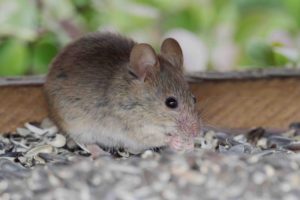
Mouse eating seeds from a bird feeder. Shutterstock.
- garbage cans with food spillage
- bird feeders that drop seed onto the ground
- pet food bowls left outside
- pet poop accumulating in the yard
- nuts from oaks and other nut trees on the ground
- seeds from certain flowering plants (sunflowers!)
- stored birdseed or grass seed in shed or garage
- fallen or rotting garden vegetables and fruits on the ground
Outdoor Mouse Shelter Provided By You:
- woodpiles, especially near the house
- stacks of bricks, stones, debris
- piles of mulch or grass clippings
- tall grass, weeds, or heavy brush
- dense ground-covers or thick shrubbery
- junk cars or old equipment
Another reason why you ended up with mice entering your house is because they could. Older homes and others with gaps and openings to the outside are more prone to mice moving in. Food odors (spilled dog food or bagged garbage in the garage, for example) are attractants, as well.
HOW DID MICE GET IN?
Mice, especially young mice, can enter a space through a surprisingly small opening. All they need is a gap about 3/8-inch high or a hole smaller than the size of a nickel. If mice find an opening that isn’t quite big enough and it’s a material that they can chew (most things), they will just gnaw to make the opening larger so they can fit through.
Mice usually enter through openings around the foundation. The space left around gas lines, power lines, cables and other utility conduits that enter the house, as well as unscreened foundation vents, let mice inside. Mice can also enter through gaps where exterior framing or siding meets the foundation.
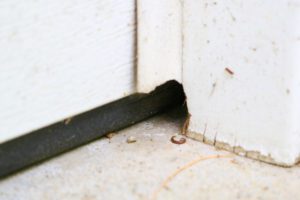
Mice chewed to enter at garage door weather stripping. Z. Ciras
Ground floor doors that are missing thresholds, sweeps, or weather-stripping provide an entry point. Garage doors rarely have a tight seal and are notorious for allowing mice inside (see Maintain Your Garage Door to Keep Mice Out). Once in the garage, mice can enter the house or attic by following pipes or utility lines or simply squeezing under a door. Mice, especially deer mice, can also get into home attics or ceiling voids from outside by following tree branches or cables or lines that enter near the roofline, or by entering vents.
In apartment buildings, mice commonly move from one unit into the next by squeezing into the opening around pipes or utility lines and using them as a highway to move through voids to reach units above, below, or next door. The opening around pipes under the kitchen sink is a common entry point for mice. Mice can even reach upper floors from the ground level by climbing up trash chutes and utility lines in high-rise buildings. See Mice in Apartment Buildings.
HOW CAN YOU KEEP MICE OUT?
Besides correcting outside conditions that attract mice to your yard (see above), the best way to keep them out of your house is to do some caulking and sealing, and screening and reinforcing of areas where mice enter. These steps are called mouse exclusion measures or mouse-proofing and Colonial Pest can do this work for you. Mouse exclusion also involves adding sweeps or thresholds to doors, with special attention paid to the garage door.
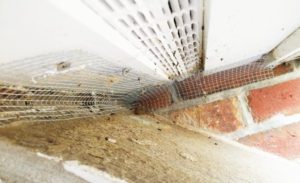
Galvanized steel screening used in a Mouse Exclusion at the chimney and soffit juncture. Z. Ciras.
Mouse exclusion is time-consuming and you can do the work yourself, but our pros know how mice think and where mice find openings. Plus, our technicians use gnaw-proof materials and their work is guaranteed!
For more information, see Is My Home a Candidate for Mouse Exclusion Methods?
SIGNS OF MICE
Since mice are most active at night, you are more likely to see evidence left by mice before you actually see the mice themselves.
Mouse droppings or poop –
One of the first noticeable signs that you have mice are mouse fecal droppings that are similar in shape to a grain of rice, but smaller and black. A single mouse can leave about 70 droppings a day in small, random groupings along its travel routes to find food. (HINT: If the droppings are shiny black, soft and putty-like, they are fresh. If they’re dull black or gray and crumble when squeezed, they’ve been around a while.)
Mouse nests –
Mouse nests and nest material may not be as obvious as droppings since nests are constructed in little disturbed, out-of-the-way locations but that are in close proximity to food (usually less than 30 feet). Typical nest sites are back corners of little-used bottom kitchen cabinets, behind appliances, in stove pan drawers, in dresser drawers or closet corners, or in storage boxes.
You might not have seen a nest but you might have seen evidence left by the pregnant female mouse as she collects any soft nest material she can find: shredded tissues or paper, paper towels, pieces chewed out of soft fabrics, yarn or string, cotton balls, dental floss, insulation, upholstery fill or pillow stuffing.
Don’t expect a mouse’s nest to be a cute little ball of fluff. It’s more often a rather messy, flattened wad of stuff, about 4 inches in diameter (larger for deer mice). It may also contain hoarded food, mouse poop, and mouse babies.
Other evidence of mice –
- Gnawed areas at the bottom of wooden doors, around pipe openings under sinks, and any other place where mice want to enter.
- Dark, greasy-looking rub-marks, from the oils in the mouse’s hair, around openings it uses and along edges where it travels.
- Hoarded food, including pet food and birdseed, which the mouse stores in hidden areas, sometimes in wall voids.
- Unusual scratching, gnawing, scurrying, or squeaking sounds, especially at night and generating interest from your pets.
For more, see No Wonder Mice Are Such Good Pests!
WHAT KIND OF MICE ARE THEY?
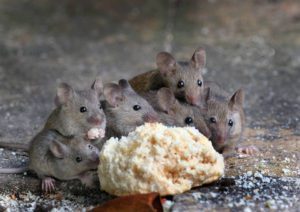
House mice enjoying some cake. Shutterstock.
House mice are the rodents most often found nesting and living in homes and apartments. However, deer mice have been moving inside and are the primary invaders in some areas where homes are on wooded lots. This change in behavior is important in our region because deer mice are host animals for the tick that transmits Lyme disease (see DISEASE AND ASTHMA CONNECTIONS below).
Both house mice and deer mice are about the same size at an average 6 inches in length for the adults, including the tail. Both types of mice have similar habits and nest in similar sites indoors, although deer mice are more likely to be found in garages, attics (they’re good climbers), or sheds. Deer mice are also more likely to forage outside for food so their nest sites and food hoards can be found to contain large quantities of seeds and nuts, their primary foods.
House mouse (Mus musculus) –
Mostly solid gray (sometimes brown) coloration; naked tail is uniform gray top and bottom.
Deer mouse (Peromyscus maniculatus) –
Two-tone coloration, tawny brown (rarely gray) on top with a white belly and feet, and a hairy two-tone tail. Has larger ears and eyes than the house mouse and is generally regarded as “cuter.” Hard to tell apart from the closely-related white-footed mouse. See Are Deer Mice More Common Than House Mice?
TRAPS OR POISON?
When you have mice, contacting a pest control professional is always the way to go. But there are always people who want to try the DIY approach. People ask, “Which is better? Should I use traps or poison bait?” There’s no one answer since each method has advantages and disadvantages, and many things have to be considered – another reason to bring in a professional.
If there are children or pets in the house, you probably don’t want to use poison baits, known as rodenticides. If you do, make sure you place them in inaccessible areas and in tamper-resistant bait stations so that children can’t reach the bait. Even if there are no children living in the house, grandchildren (and pets) may still visit.
Poison baits may not be the best choice in kitchens, the number one location for mice. Mice have so many competing food choices in kitchens that they may be less interested in bait. With poison baits, you don’t have to remove dead mice from traps but you can’t control where that mouse might die. You can end up with an odor problem from a dead mouse in an inaccessible void.
Rodent snap traps don’t involve poisons or result in odors from hidden mouse carcasses, but they do require diligence on your part to set the traps, place them, check them, and discard any dead mice…on a repeat basis. Rodent glue traps are another somewhat messier option used less often.
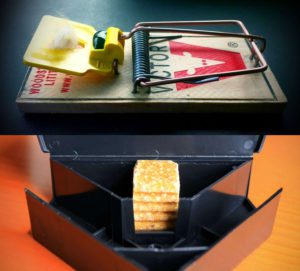
Examples of a baited snap trap and a bait station with anticoagulant bait inside. Z. Ciras
Whether you use traps or toxic baits, you need to know where to place them for best results. Contact Colonial Pest instead. Our pros know where traps work best and where poison baits might be the better choice. And, we’ll be around until the last mouse is gone.
DISEASE AND ASTHMA CONNECTIONS
Having mice in your house or apartment is more than just a nuisance and more than a sanitation issue. Mice can carry various parasites and diseases. Accumulations of mouse droppings and urine from long-ignored infestations are a special concern in situations where airborne particles might be disturbed and inhaled.
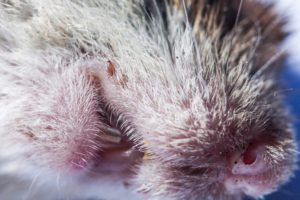
Ticks and disease carrying insects are found on many mice. Shutterstock.
Deer mice can transmit hantavirus and are host animals for the black-legged tick that transmits Lyme disease. When mice enter your house, it’s possible that they are carrying infected ticks on their bodies.
Like dust mites, cockroaches, and certain other insect pests, house mice are implicated in cases of asthma, particularly among children. Mouse allergens are found in mouse urine, poop, and dander and inhaling airborne allergens can cause serious reactions in sensitive people. See Mice Can Be a Trigger for Asthma.
GOT MICE? CALL COLONIAL PEST TODAY!
Usually by the time that you discover that you are living with a mouse in your house, it’s almost certain that there are many more. Mice reproduce quickly so you really can’t afford to ignore the problem while you study your options.
We always recommend that you contact a pest management professional ASAP to handle an indoor mouse problem. Pros know where to look and what to use to eliminate the mouse infestation safely and with the least disruption for your family. Even better, pros also know how to keep it all from happening again!
For much more, see our website service section on Mice/Rodent Removal.